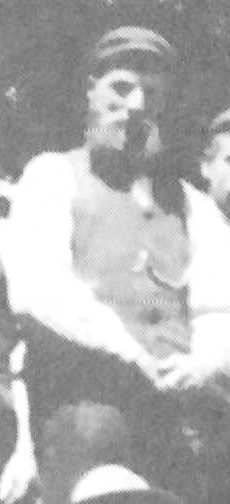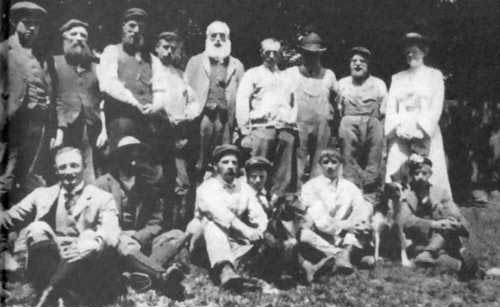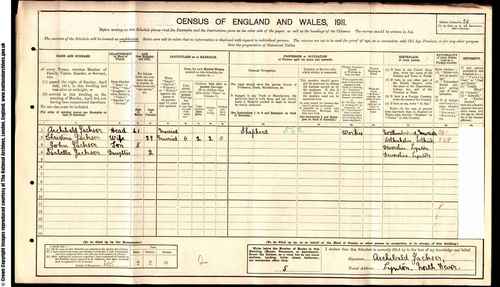
Archive Ref: 3394/138/2
Archie Jackson was born in 1870 in Northumberland of Scottish parents, John and Isabella Jackson of Roxburghshire. He had one brother, James, and three sisters Margaret, Janet and Isabella all recorded in the 1881 census when the family were living in Selkirkshire on the Scottish/English border.
Archie married Christine Mitchel in Selkirk in 1904 shortly before they moved to Exmoor. He was 41 and she was 29. Archie took over the Hoar Oak herding after James Maxwell Johnstone’s death in March 1904 and was employed by the Fortescue family. He was the last Scottish shepherd to be employed at Hoar Oak Cottage and the photograph below shows Lady Margaret Fortescue (far right) with the Exmoor shepherds at shearing time in 1905. In the photograph below Archie Jackson is third from the left in the back row.

Archive Ref: 3394/HOC49
Photo thanks to Roger Burton.
Archibald and Christine had two children at Hoar Oak Cottage as shown in the 1911 census, details and image below:
- Head of Household, Age 41, Shepherd. Born in Newcastle
· Christine: Wife, Age 29, Born in Selkirk, Scotland
· John: Son, Age 5, Born Hoar Oak Cottage, Registered in Lynton.
· Isabella: Daughter, Age 2, Born Hoar Oak Cottage, Registered in Lynton.

Archive Ref: 3394/HOC131
Archie seems to have had some success in sheep dog trialling on Exmoor as recorded in the North Devon Journal of July 1904. Sheep dog trials appear to have been introduced to North Devon by the Scottish shepherds who (perhaps not unsurprisingly) did well at them and as the news item reports; Archie Jackson of Hoar Oak won second place and prize money of 10 shillings and 6 pence.
We find information about Archie and his time at Hoar Oak in the diaries of George Cobley Smyth-Richards who was Land Agent for the Fortescue Estate at the time.
16 April 1906 “I rode over to Hoar oak and saw Jackson and had a look around and I decided to have the East wall tarred and probably the front cemented if it was required. “
1 March 1907 “I also saw young Little of Pinkery who complained that Jackson had smacked his face.”
2 March 1907 “I had Jackson in to see me and had a long talk with him as to his herding and I told him he must manage better or I must change him and I particularly gave him instructions as to his skins. I found he had not brought in these.”
5 September 1907 “Saw his Lordship and discussed the matter of the Hoar Oak sheep. There are 30 missed there and the question is how so many can have been missed.”
9 September 1907 “We [George Cobley Smyth-Richards and Lord Fortescue] rode back across to Hoar Oak. Inspected the farm and the herding. Personally his Lordship was of opinion it would pay to let it, but I am not of that opinion for the herding would be spoilt.”
13 January 1908 “I had a long talk with his lordship as to the sheep in the Oar Oak [corrected to read Hoar Oak in the margin] herding and it appears to me that Jackson should have notice to leave.”
27 January 1908 “Had a look at Hoar Oak House and found it very damp and decided to tar the whole of the outside and see if that will keep it dry.”
Diaries held at Devon Record Office Ref: DRO1262M/E26/3 et seq
There may be more in the diaries but for the moment this is where we leave them. We do know from the census records, as shown above, that the Jacksons were still at Hoar Oak in 1911. These were hard times on Exmoor and Roger Burton in his text The Heritage of Exmoor (1989) notes that not only were the prices received for meat and wool poor at this time but also that Viscount Ebrington, the heir to the Fortescue Estate, and his Agent George Cobley Smyth-Richards were seeking to wind up much of the sheep farming in order that the farms could be let out to tenants thus earning income for the Fortescue Estate. This had a grave impact on the shepherds and their livelihoods and Burton notes that the changeover was not an easy one with a certain amount of friction between the shepherds and the Agent.
It seems that for a short period of time the Bass family were living in Hoar Oak Cottage, after the Jacksons and before the arrival of the Hobbs family in 1913/1914, so we can surmise that Archie and Catherine and their children left around 1912/1913.
Thank you to Graham Wills for sharing his researches of the Fortescue Estate Land Agent’s diaries which have helped to fill in some of the story of Archie Jackson.
There is still more to learn about the Jacksons. If anyone has further information please contact us.
